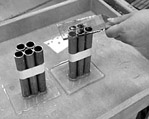- ANSI/NSF 61: Drinking Water System Components-Health Effects
This is the health standard for all plumbing products and materials that come in contact with potable water. Copper water tube, copper fittings, and copper and brass plumbing valves and fixtures are covered by NSF Standard 61. The Standard specifies that copper tube be evaluated at a pH of 6.5, rather than at the pH of 5 and 10 for other material types. - ANSI/ASME B16.22: Wrought Copper and Copper Alloy Solder-Joint Pressure Fittings
As its name implies, this specification governs the elbows, tees and other solder-type fittings used to join standard plumbing tube. The copper used in these products has the identical 99.9 percent purity as standard copper water tube. - ASTM B32: Standard Specification for Solder Metal
This specification covers the solders used to join copper tube and fittings. Today's plumbing solder contains no lead. - ASTM B 88: Standard Specification for Seamless Copper Water Tube
This specification covers Copper UNS No. C12200 seamless copper water tube suitable for general plumbing, and similar applications for the conveyance of fluids, and commonly used with solder, flared or compression type fittings. The type of copper water tube suitable for any particular application is determined by the internal or external fluid pressure, by the installation and service conditions and by local requirements. Means of joining or bending are also factors that affect the type of tube to be used.
End Use Marks
NSF-61
Products bearing the NSF-61 mark are certified by NSF International to ANSI/NSF Standard 61 for health effects only. Certification does not include performance evaluation.
NSF-pw
Products bearing the NSF-pw mark are certified by NSF for all applicable performance standards for pressure-rated potable water applications and also to ANSI/NSF Standard 61 for health effects.
NSF Certification
 The U.S. Safe Drinking Water Act (1996) and the Lead and Copper Rule (1991) require public water suppliers to provide noncorrosive drinking water to their customers. Typically, this is accomplished through the use of pH adjustment (pH 6.5 to 8.5) and through the addition of corrosion inhibitors such as ortho- and polyphosphates. The resultant tap water concentrations of lead and copper must be below the action levels of 15ug/L and 1300ug/L, respectively.
The U.S. Safe Drinking Water Act (1996) and the Lead and Copper Rule (1991) require public water suppliers to provide noncorrosive drinking water to their customers. Typically, this is accomplished through the use of pH adjustment (pH 6.5 to 8.5) and through the addition of corrosion inhibitors such as ortho- and polyphosphates. The resultant tap water concentrations of lead and copper must be below the action levels of 15ug/L and 1300ug/L, respectively.
NSF International has certified several copper tube and fittings manufacturers to ANSI/NSF Standard 61. All have the limitation of being certified for use in non-corrosive aqueous environments. Specifically, the pH must not be below 6.5. Otherwise, resultant copper concentrations in tap water may exceed the action level established by the EPA.
ANSI/NSF Standard 61 requires products evaluated to conditions other than those specified in the standard (such as pH 5 and 10 exposure water) to be labeled with a limitation statement, as follows:
Copper tube (Alloy C12200) is Certified by NSF to ANSI/NSF Standard 61 for public water supplies meeting or in the process of meeting the EPA Lead and Copper Rule (56FR 26460, June 7, 1991). Water supplies with pH less than 6.5 may require corrosion control to limit copper solubility in drinking water.
NSF Certified copper tube must bear the NSF Certification mark and the limitation statement. The length of the limitation statement makes it difficult to place on the tube itself. Additionally, current inking technology results in smearing and low legibility. For these reasons, NSF certification policies allow copper tube manufacturers to place the limitation statement on a tag attached to bundles of copper tube, or on the boxes of coiled copper tube. Placing "NSF" on the tube itself is still required.
